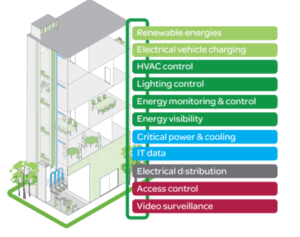Perhaps no other facility has as diverse an infrastructure as colleges and universities. To meet the needs of students, numbers of which can reach 30,000 or more, universities must run as self-sufficient cities in-and-of-themselves. A campus has office buildings, hotels, student accommodation, data centers, restaurants, shops, gyms and other sports facilities, entertainment complexes, and lecture theaters. Research or specialty universities can include museums, medical centers, agricultural centers, high security biomedical laboratories, and many other buildings with unique characteristics and varying energy needs.
Infrastructure to maximize security and energy efficiency on campus
With such diversity of use, the operations and maintenance staff responsible for campus facilities must consider not only the energy and security factors of today, but also those that may exist in the future. A university must have an infrastructure that provides the flexibility to adapt and grow with the institution.
All too often, higher education establishments operate multiple, siloed systems that equate to disparate, incompatible, and isolated infrastructures. Such systems are costly to install, operate, and maintain as they do not share equipment, cabling, software, etc., and because facilities management must retain the expertise to operate and maintain each system. The costliest element of siloed systems is that they do not share data—a lost opportunity when it comes to optimizing both energy efficiency and security.

Campus as a true ecosystem
Due to the range of building uses on campuses, energy demands differ greatly from building to building. In residential housing for example, students usually have some degree of manual control and can personalize heating, ventilation, air conditioning (HVAC), and lighting systems. In a teaching building, the facilities staff will likely schedule the HVAC systems and dictate room temperature set-points with little or no occupant override capabilities provided. Even tighter controls may be specified for laboratories, where strict control of airflow, humidity, and temperature may be required.
So, what is special about conserving energy at colleges and universities? And, what energy management strategies can be implemented that result in multiple benefits uniquely suited to the campus setting? To start, the most important energy management strategy is an integrated infrastructure that allows for the seamless integration of all building systems, services, and applications. This is the foundation for an efficient campus that functions as a true ecosystem, rather than a myriad of diverging systems that operate independently and do not share information.
By integrating the key domains of an enterprise— power management, IT room management, process & machine management, building management, and security management—a campus can be optimized for maximum efficiency. Specifically, an integrated infrastructure aggregates data from multiple systems, enabling university leaders and facility directors to see, measure, and mange energy use across the entire campus.
Furthermore, a truly integrated infrastructure should be based on open, non-proprietary standards. This can help universities leverage existing equipment and reduce redundant devices and software. An infrastructure based on open standards can also accommodate new technologies as they emerge, without the need for major re-configurations.
Finally, an integrated infrastructure that enables communication between HVAC control, lighting control, security, IT networks, electrical power networks, and energy metering can control energy consumption, provide comfort and security to occupants, and protect property.
Elements of an integrated infrastructure
Power management
The integration of power management application forms help to ensure the availability of power, reduces energy bills (water, air, gas, electricity, and steam), limits CO2 emissions, and enables the use of renewable energy. Examples of solutions include: power measurement, intelligent power and motor control, renewable energy conversion, and electric vehicle charging technologies.
Within this domain, universities can harness the power of the smart grid. Communication with the smart grid enables universities to modify their patterns of energy use to avoid expensive peak rates, allow for the integration of on-site generation, and become generally more efficient regardless of time of day. Smart grid information also allows informed decisions regarding duel sources. For example, universities that desire the greenest forms of generation, can alter energy use patterns to fit times of day when the renewable contribution to the grid is at its highest.
IT room management
Campuses often have data centers full of academic records and student data; IT solutions should ensure the availability of servers, protect critical data and applications with ultra-secure power and fast server adjustment, and optimization of energy costs with cooling and energy reports. Within campus data centers, uninterruptible power supply (UPS) and critical power and cooling are important components of a smart and reliable university infrastructure.
Process & machine management
As mentioned, a university has many different types of buildings across its campus. Another type of facility that could be included in this portfolio is a physical plant or water/wastewater plant. A comprehensive higher education solution could include the running of a productive plant, ensuring efficient processes, and machine performance. This optimizes engineering, operations, energy, and maintenance costs. Another area that this type of solution could positively affect is within the university food services organisation: making sure that processes are run in the most optimal way while ensuring efficiency and cost savings.
Building and security management
A vital aspect of an efficient campus is the native integration of building and security systems via an intelligent Building Management System (iBMS). This solution, based on open, standards-based technology, enables universities to fully integrate all building systems on one network—across enterprises—from a single software platform. A single user interface, accessible locally or remotely via the web, gives users a complete view of all university systems, including HVAC, lighting and lighting control, energy metering, access control, video surveillance, intrusion, fire and smoke detection, electrical distribution, and power quality and monitoring.
For campuses with laboratories, providing the best environmental and living conditions has a significant impact on operations compliance, quality and sustainability. The importance of properly designing, operating and maintaining a Building Management System (BMS) is critical to provide the research data quality as required by regulatory authorities. That is why being able to integrate all facility systems through a secure BMS is essential to deliver safe and effective analysis and examination to patients.
EV charging and management
With an ever-changing world and new government proposals changing the way we will consider transportation needs in the future, there is a huge question around whether allocated power will be insufficient as the demand and number of Electric Vehicle Chargers in operation grows.
There will be many more EV’s on the road, with bigger batteries and a greater demand on the EVC system than anyone (but the city planners) expected in the last 2-3 years. Ultimately, many static energy management EV charging systems will struggle to meet the power demands of the vehicles within the infrastructure and power limits that have been designed.
With the challenges stated in mind, one solution to date has been to provide a maximum power provision for the EV Charger network in the building. In the unlikely (based on past EV sales) event, a high number of vehicles were plugged into the system, the system would balance the dedicated load across the chargers in use – reducing the amount of charge given to the vehicle and extending the overall charge.
As most residential developments spend a large proportion of time well below peak power, the EVC system utilizes the ‘un-used’ power availability within the building. At times of high-power usage (usually in the evening for short periods) it will dynamically reduce the load to the EV Chargers for a short period of time. This is normally just before the minimum power usage throughout the night when most vehicles are static and charging.



